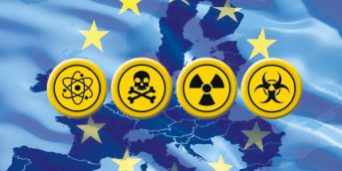The following definitions are excerpt from a study on “EU preparedness and responses to Chemical, Biological Radiological and Nuclear (CBRN) threats”. The study, requested by the European Parliament’s Subcommittee on Security and Defence (SEDE) in 2019 and published in 2021, takes stock of the existing preparedness and response mechanisms and compares these against the changing threat landscape to determine the current state of play of the EU’s response tools and its remaining gaps where improvement may be needed.
Definitions:
“CBRN functions as an acronym to describe chemical, biological, radiological, and nuclear materials and agents ‘that could harm the society through their accidental or deliberate release, dissemination, or impacts’. The term ‘CBRN’ goes back to cold war where it was first referred to as ABC (atomic, biological, chemical) and later as NBC (nuclear, biological, chemical). A variation of the current term is CBRNE (also spelt CBRN-E or CBRNe) which incorporates explosive substances or events into CBRN. (…)
Chemical weapons are harmful as a result of the toxic effects produced by chemical reactions. One generally distinguishes five classes of chemical weapons. These are irritants, choking or pulmonary agents, blister agents, blood agents and nerve agents. The most basic chemical weapons release gaseous or highly volatile chemicals, such as hydrogen cyanide or chlorine gas.
Biological weapons harm their targets by infecting them with natural or deliberately produced toxins or pathogenic micro-organisms, some of which may also be contagious. The US National Institute of Allergy and Infectious Diseases (NIAID) has identified the following six biological agents as posing the highest risk to public health and national security: bacillus anthracis (anthrax), clostridium botulinum toxin (botulism), yersinia pestis (plague), variola major (smallpox) and other related poxviruses, Francisella tularensis (tularemia) and viral hemorrhagic fevers, such as Ebola. (…)
As for radiological weapons, they are harmful to their targets through the radiation emitted by the radioactive material that they contain. It is possible to produce radioactive material – that is, material emitting radiation – through nuclear processes. However, there are also some natural radioactive materials, like potassium, thorium and uranium. Radioactive materials can be used in radiological dispersal devices (RDD), which spread radioactive material (e.g. a ‘dirty bomb’) or in radiation exposure devices (RED), which can expose persons to harmful doses of radiation whilst being hidden from sight. RDDs are not as destructive as nuclear weapons but can nevertheless have a significant impact, especially in densely populated areas. Finally, nuclear weapons can cause a huge amount of destruction as a result of nuclear reactions – that is, nuclear fission, nuclear fusion, or a combination of both. They can produce mass destruction through radioactive fallout, shock waves and extreme heat. They can also interrupt communications and control systems as a result of electromagnetic pulses, which can cause secondary damage or system failures. Whilst nuclear weapons are potentially the most harmful of all CBRN weapons, they are also the most complex to acquire or develop.”







